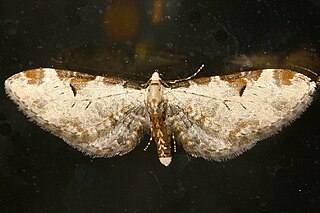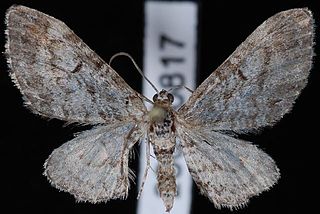
Eupithecia miserulata, the common eupithecia, is a moth of the family Geometridae. The species was first described by Augustus Radcliffe Grote in 1863 and it can be found in North America, from Ontario and Maine in the north to Florida, Mississippi, Louisiana and Texas in the south. It is also found in Arizona and California.
Eupithecia pinata is a moth of the family Geometridae. It is found in North America. It was described by Samuel E. Cassino in 1925.

Eupithecia acutipennis is a moth of the family Geometridae first described by George Duryea Hulst in 1898. It is found in the US state of California.
Eupithecia herefordaria, or Hereford's eupithecia, is a moth in the family Geometridae. It is found in south-eastern Arizona, United States.
Eupithecia nimbosa is a moth in the family Geometridae first described by George Duryea Hulst in 1896. It is widespread in the Rocky Mountains, from Arizona to the Canada–US border.

Eupithecia nevadata is a moth in the family Geometridae first described by Alpheus Spring Packard in 1871. It is found in western North America.

Eupithecia graefi, or Graef's pug, is a moth in the family Geometridae. The species was first described by George Duryea Hulst in 1896. It is found in North America from south-western Alberta west to Vancouver Island, north to Alaska and south to California. The habitat consists of wooded areas.

Eupithecia misturata is a moth in the family Geometridae first described by George Duryea Hulst in 1896. It is widely distributed in western North America.
Eupithecia palmata is a moth in the family Geometridae first described by Samuel E. Cassino and Louis W. Swett in 1922. It is found in the US state of California. The habitat consists of deserts.
Eupithecia alpinata is a moth in the family Geometridae first described by Samuel E. Cassino in 1927. It is found in the US states of Texas and Arizona.
Eupithecia biedermanata is a moth in the family Geometridae first described by Samuel E. Cassino and Louis W. Swett in 1922. It is found in the US state of Arizona.
Eupithecia zelmira is a moth in the family Geometridae first described by Louis W. Swett and Samuel E. Cassino in 1920. It is found in the US states of Oregon and California.
Eupithecia vitreotata is a moth in the family Geometridae first described by Samuel E. Cassino in 1927. It is found in the US states of Colorado, Arizona and California.
Eupithecia woodgatata is a moth in the family Geometridae first described by Samuel E. Cassino and Louis W. Swett in 1923. It is found in the US states of Arizona, New Mexico and California.
Eupithecia joanata is a moth in the family Geometridae first described by Samuel E. Cassino and Louis W. Swett in 1922. It is found in southern California, United States.

Eupithecia gilvipennata is a moth in the family Geometridae first described by Samuel E. Cassino and Louis W. Swett in 1922. It is found along the North American Pacific coast from British Columbia, through Colorado to California and Arizona.
Eupithecia shirleyata is a moth in the family Geometridae first described by Samuel E. Cassino and Louis W. Swett in 1922. It is found in the US in southern California and Arizona.
Eupithecia gilata is a moth in the family Geometridae first described by Samuel E. Cassino in 1925. It is found in the US states of Arizona and California.
Eupithecia tricolorata is a moth in the family Geometridae first described by Samuel E. Cassino in 1927. It is found in the United States in southern Arizona.
Prorella albida is a moth in the family Geometridae first described by Samuel E. Cassino and Louis W. Swett in 1923. It is found in the US states of California, Utah, New Mexico, Colorado and south-western Texas.





